Tree Diameter at Breast Height (DBH) Estimation Using an iPad Pro LiDAR Scanner: A Case Study in Boreal Forests, Ontario, Canada
Abstract
:1. Introduction
2. Materials and Methods
2.1. Study Area
2.2. Data Acquisition
2.2.1. Validation Data
2.2.2. LiDAR Data
2.3. Point Cloud Processing
2.4. Statistical Methods
3. Results
3.1. Validation Data
3.2. Impact of Site- and Tree-Level Factors on Estimation Accuracy
3.3. Hypotheses
4. Discussion
5. Conclusions
Author Contributions
Funding
Data Availability Statement
Acknowledgments
Conflicts of Interest
References
- Bauwens, S.; Bartholomeus, H.; Calders, K.; Lejeune, P. Forest Inventory with Terrestrial LiDAR: A Comparison of Static and Hand-Held Mobile Laser Scanning. Forests 2016, 7, 127. [Google Scholar] [CrossRef]
- Chiappini, S.; Pierdicca, R.; Malandra, F.; Tonelli, E.; Malinverni, E.S.; Urbinati, C.; Vitali, A. Comparing Mobile Laser Scanner and Manual Measurements for Dendrometric Variables Estimation in a Black Pine (Pinus Nigra Arn.) Plantation. Comput. Electron. Agric. 2022, 198, 107069. [Google Scholar] [CrossRef]
- Aijazi, A.K.; Checchin, P.; Malaterre, L.; Trassoudaine, L. Automatic Detection and Parameter Estimation of Trees for Forest Inventory Applications Using 3D Terrestrial LiDAR. Remote Sens. 2017, 9, 946. [Google Scholar] [CrossRef]
- Balenović, I.; Liang, X.; Jurjević, L.; Hyyppä, J.; Seletković, A.; Kukko, A. Hand-Held Personal Laser Scanning: Current Status and Perspectives for Forest Inventory Application. Croat. J. Eng. 2021, 42, 165–183. [Google Scholar] [CrossRef]
- Gollob, C.; Ritter, T.; Kraßnitzer, R.; Tockner, A.; Nothdurft, A. Measurement of Forest Inventory Parameters with Apple iPad Pro and Integrated LiDAR Technology. Remote Sens. 2021, 13, 3129. [Google Scholar] [CrossRef]
- Hunčaga, M.; Chudá, J.; Tomaštík, J.; Slámová, M.; Koreň, M.; Chudý, F. The Comparison of Stem Curve Accuracy Determined from Point Clouds Acquired by Different Terrestrial Remote Sensing Methods. Remote Sens. 2020, 12, 2739. [Google Scholar] [CrossRef]
- Wang, F.; Heenkenda, M.K.; Freeburn, J.T. Estimating Tree Diameter at Breast Height (DBH) Using an iPad Pro LiDAR Sensor. Remote Sens. Lett. 2022, 13, 568–578. [Google Scholar] [CrossRef]
- Donager, J.J.; Sánchez Meador, A.J.; Blackburn, R.C. Adjudicating Perspectives on Forest Structure: How Do Airborne, Terrestrial, and Mobile Lidar-Derived Estimates Compare? Remote Sens. 2021, 13, 2297. [Google Scholar] [CrossRef]
- Shimizu, K.; Nishizono, T.; Kitahara, F.; Fukumoto, K.; Saito, H. Integrating Terrestrial Laser Scanning and Unmanned Aerial Vehicle Photogrammetry to Estimate Individual Tree Attributes in Managed Coniferous Forests in Japan. Int. J. Appl. Earth Obs. Geoinf. 2022, 106, 102658. [Google Scholar] [CrossRef]
- Apple Apple Unveils New iPad Pro with LiDAR Scanner and Trackpad Support in iPadOS. Available online: https://www.apple.com/newsroom/2020/03/apple-unveils-new-ipad-pro-with-lidar-scanner-and-trackpad-support-in-ipados/ (accessed on 6 December 2022).
- Guenther, M.; Heenkenda, M.K.; Leblon, B.; Morris, D.; Freeburn, J.T. Estimating Tree Diameter at Breast Height (DBH) Using iPad Pro Light Detection and Ranging (LiDAR) Sensor in Boreal Forests. Can. J. Remote Sens. 2024, 50, 2295470. [Google Scholar] [CrossRef]
- Veesus. ZAPPCHA: Mobile LiDAR Scanner 2022 v6.1. Veesus, St. Leonards-on-Sea, East Sussex, England. Available online: https://apps.apple.com/us/app/zappcha-mobile-lidar-scanner/ (accessed on 15 September 2022).
- Girardeau-Montaut, D. CloudCompare–Open Source Project 2022 v2.12.4 (Kyiv). Available online: https://www.cloudcompare.org/ (accessed on 18 September 2022).
- ESRI. ArcGIS Pro, v3.1.0; ESRI: Redlands, CA, USA, 2023.
- Zhang, W.; Qi, J.; Wan, P.; Wang, H.; Xie, D.; Wang, X.; Yan, G. An Easy-to-Use Airborne LiDAR Data Filtering Method Based on Cloth Simulation. Remote Sens. 2016, 8, 501. [Google Scholar] [CrossRef]
- Bivand, R.; Keitt, T.; Rowlingson, B.; Pebesma, E.; Sumner, M.; Hijmans, R.; Baston, D.; Rouault, E.; Warmerdam, F.; Ooms, J.; et al. Rgdal: Bindings for the “Geospatial” Data Abstraction Library. 2023. Available online: https://r-forge.r-project.org/projects/rgdal/ (accessed on 10 October 2023).
- Chernov, N.; Gama, J. Conicfit: Algorithms for Fitting Circles, Ellipses and Conics; 2015. Available online: https://cran.r-project.org/web/packages/conicfit/conicfit.pdf (accessed on 4 October 2023).
- Taubin, G. Estimation of Planar Curves, Surfaces, and Nonplanar Space Curves Defined by Implicit Equations with Applications to Edge and Range Image Segmentation. IEEE Trans. Pattern Anal. Mach. Intell. 1991, 13, 1115–1138. [Google Scholar] [CrossRef]
- Ontario Ministry of Natural Resources and Forestry. Vegetation Sampling Network Protocol: Technical Specifications for Field Plots; Ontario Ministry of Natural Resources and Forestry, Science and Research Branch: Peterborough, ON, Canada, 2021. [Google Scholar]
- Xia, Y. Chapter Eleven–Correlation and Association Analyses in Microbiome Study Integrating Multiomics in Health and Disease. In Progress in Molecular Biology and Translational Science; Sun, J., Ed.; The Microbiome in Health and Disease; Academic Press: New York, NY, USA, 2020; Volume 171, pp. 309–491. [Google Scholar]
- Dinno, A. Package “Dunn.Test”. 2022. Available online: https://cran.r-project.org/web/packages/dunn.test/dunn.test.pdf (accessed on 1 October 2023).
- Wang, X.; Singh, A.; Pervysheva, Y.; Lamatungga, K.E.; Murtinová, V.; Mukarram, M.; Zhu, Q.; Song, K.; Surový, P.; Mokroš, M. Evaluation of iPad Pro 2020 LiDAR for Estimating Tree Diameters in Urban Forest. ISPRS Ann. Photogramm. Remote Sens. Spat. Inf. Sci. 2021, 8, 105–110. [Google Scholar] [CrossRef]
- Tatsumi, S.; Yamaguchi, K.; Furuya, N. ForestScanner: A Mobile Application for Measuring and Mapping Trees with LiDAR-Equipped iPhone and iPad. Methods Ecol. Evol. 2021, 14, 1603–1609. [Google Scholar] [CrossRef]
- Gülci, S.; Yurtseven, H.; Akay, A.O.; Akgul, M. Measuring Tree Diameter Using a LiDAR-Equipped Smartphone: A Comparison of Smartphone- and Caliper-Based DBH. Environ. Monit. Assess 2023, 195, 678. [Google Scholar] [CrossRef]
- Tavani, S.; Billi, A.; Corradetti, A.; Mercuri, M.; Bosman, A.; Cuffaro, M.; Seers, T.; Carminati, E. Smartphone Assisted Fieldwork: Towards the Digital Transition of Geoscience Fieldwork Using LiDAR-Equipped iPhones. Earth-Sci. Rev. 2022, 227, 103969. [Google Scholar] [CrossRef]
- Corradetti, A.; Seers, T.; Mercuri, M.; Calligaris, C.; Busetti, A.; Zini, L. Benchmarking Different SfM-MVS Photogrammetric and iOS LiDAR Acquisition Methods for the Digital Preservation of a Short-Lived Excavation: A Case Study from an Area of Sinkhole Related Subsidence. Remote Sens. 2022, 14, 5187. [Google Scholar] [CrossRef]
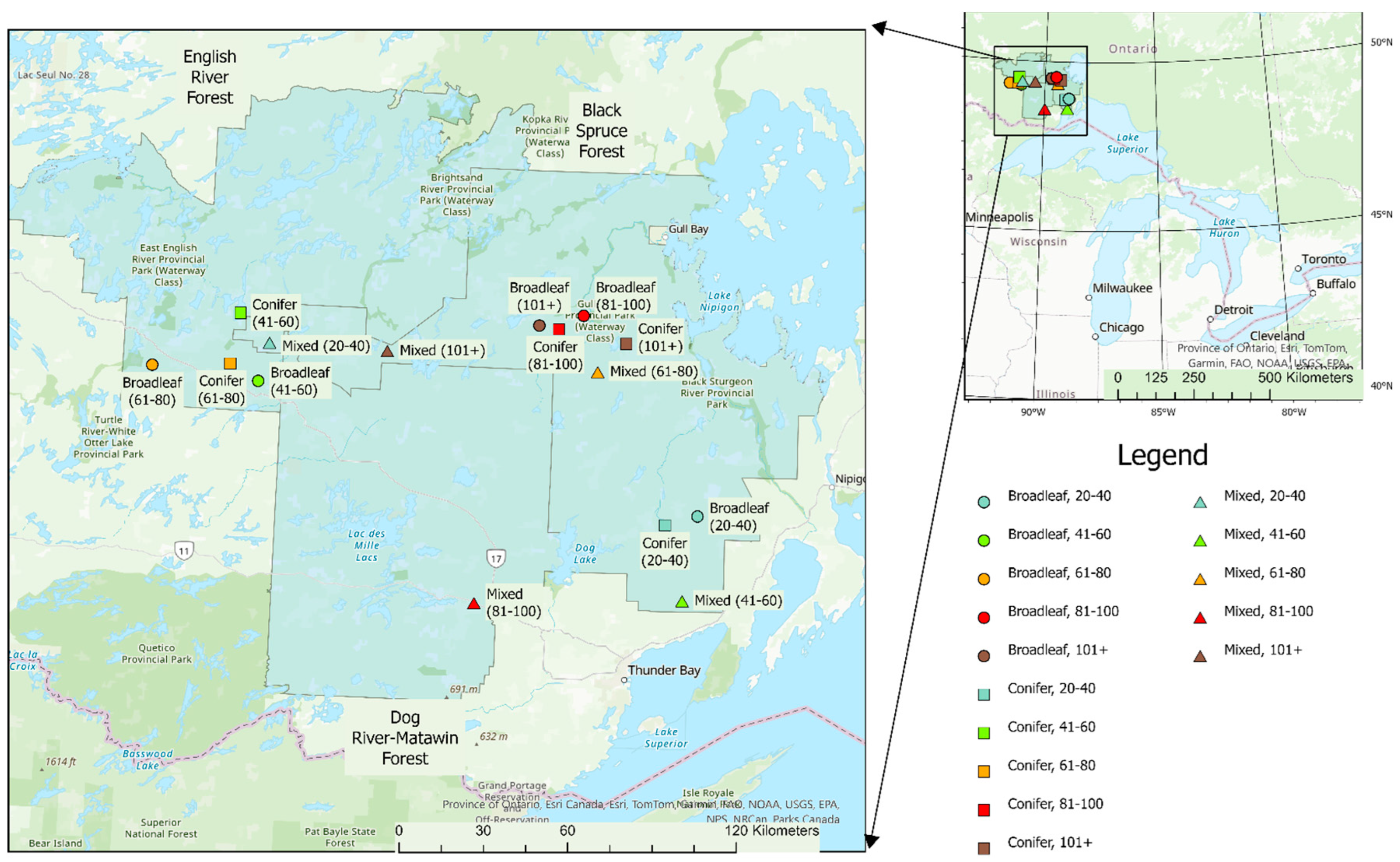
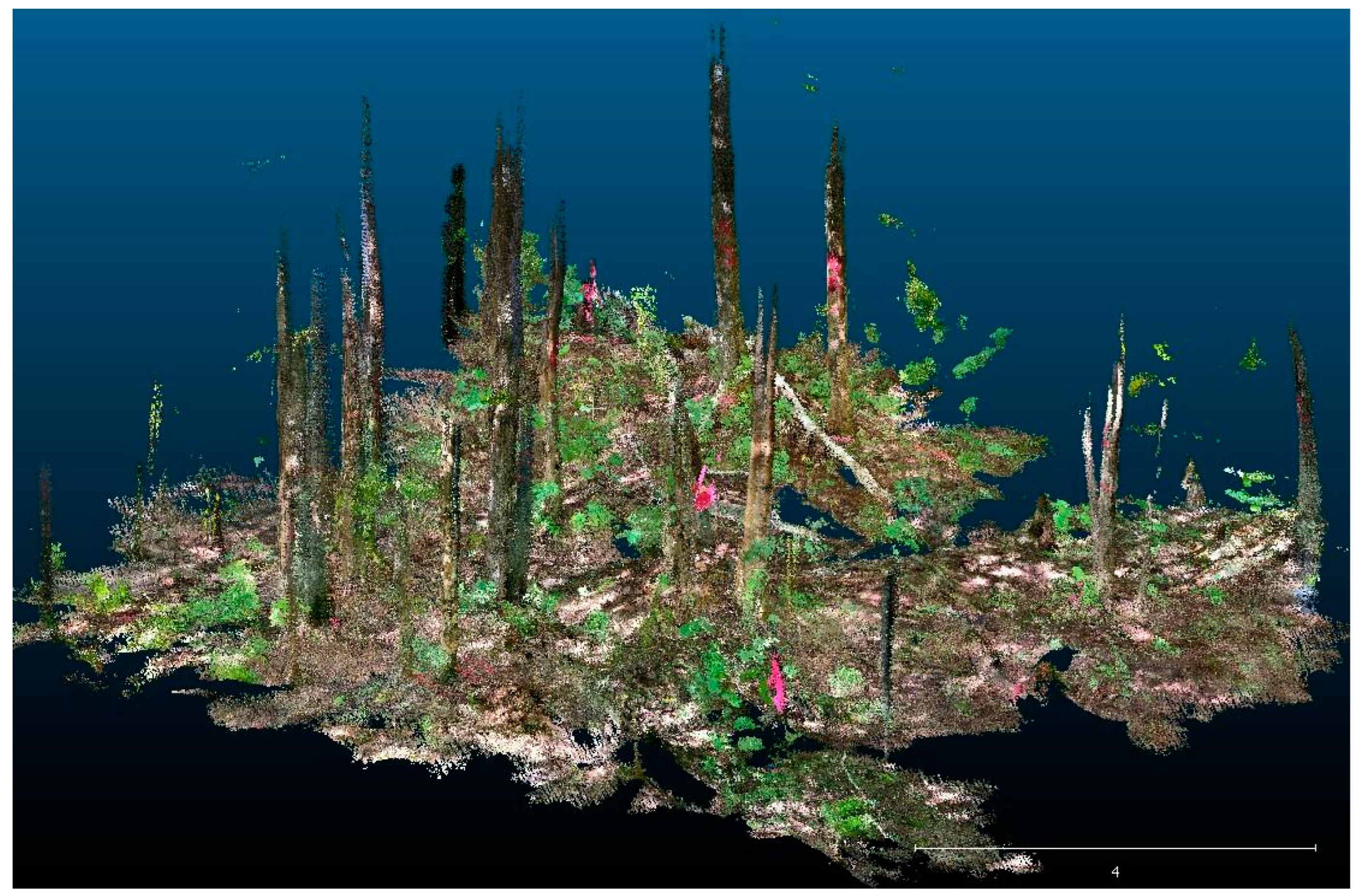
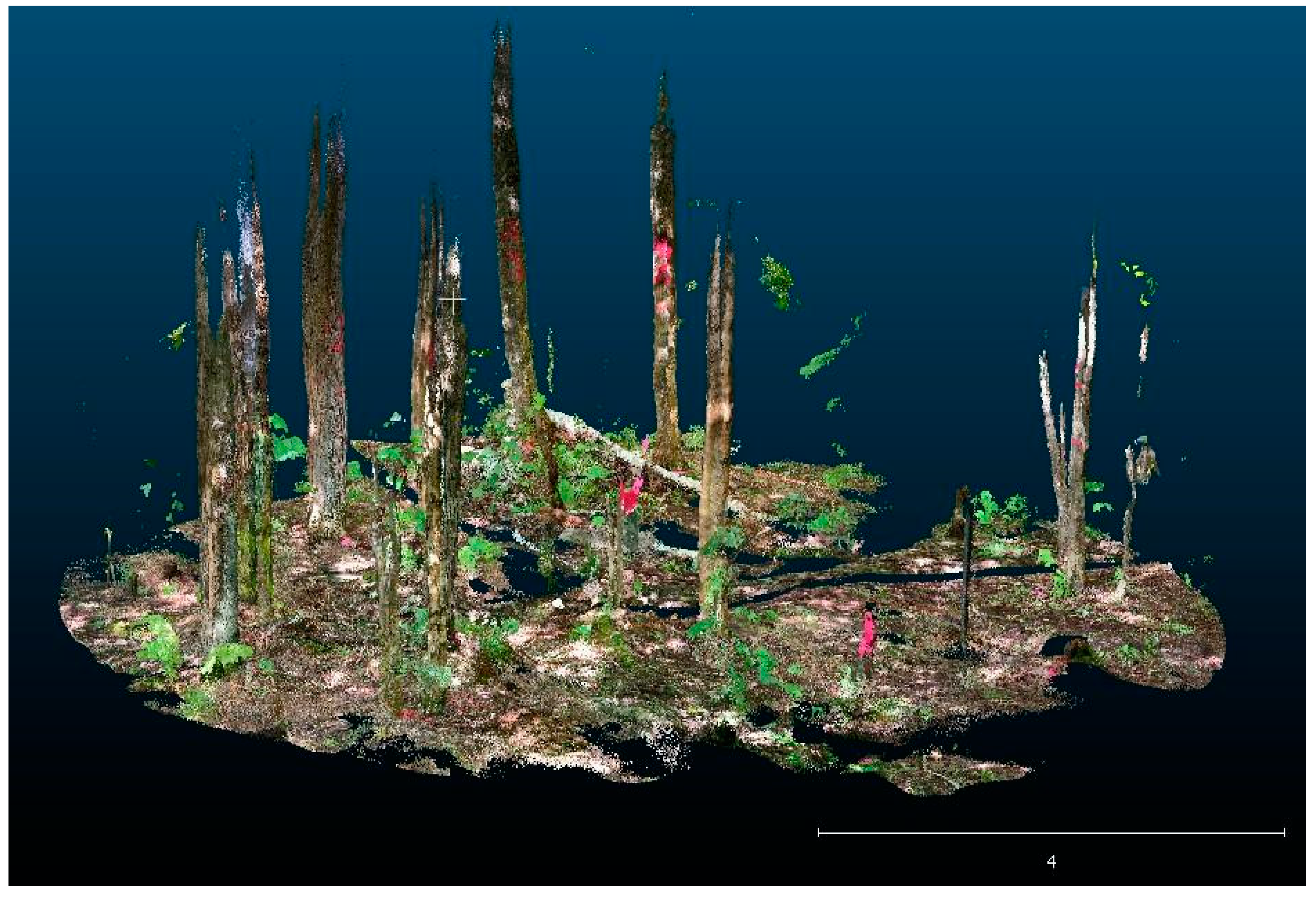
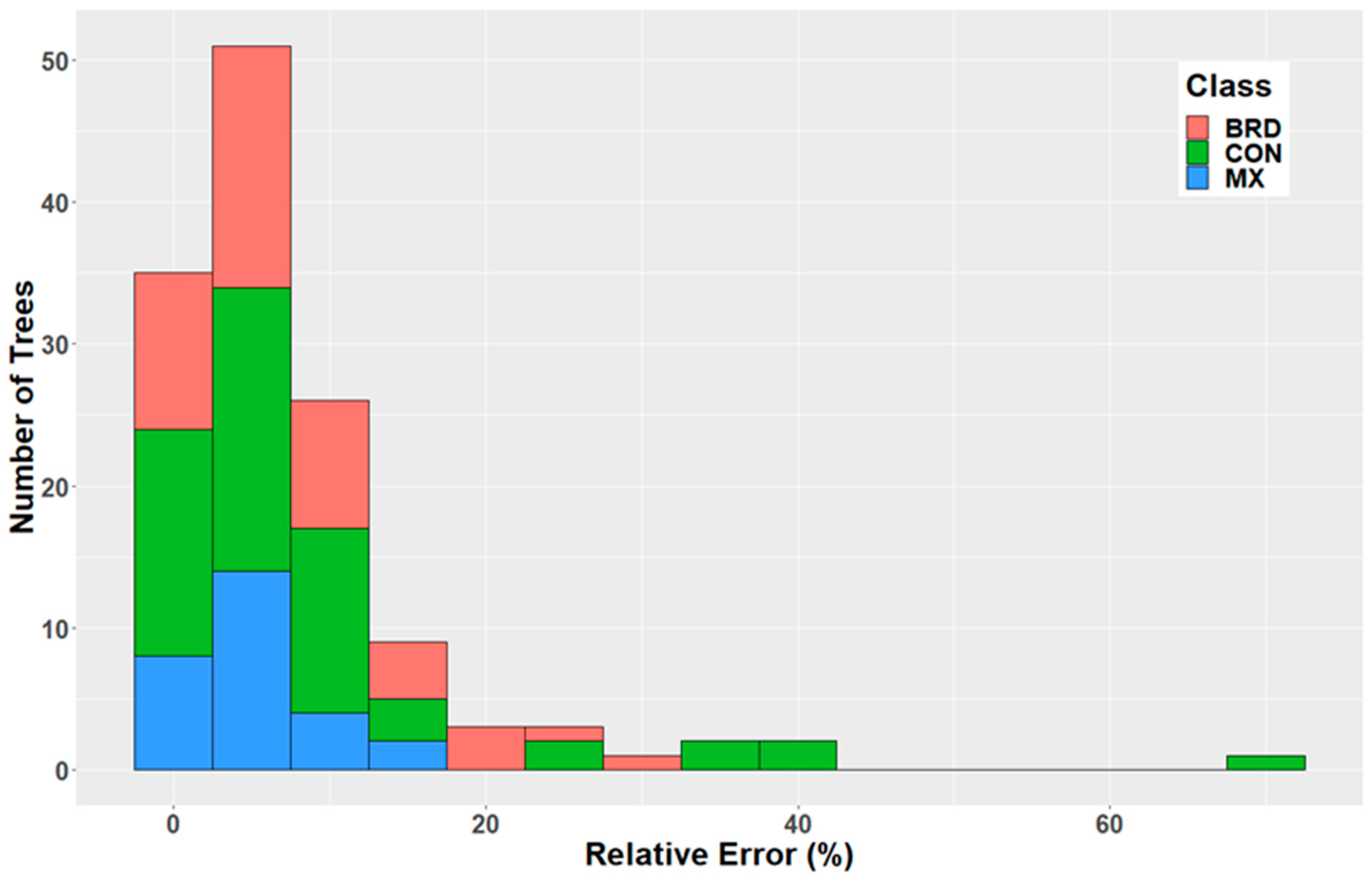
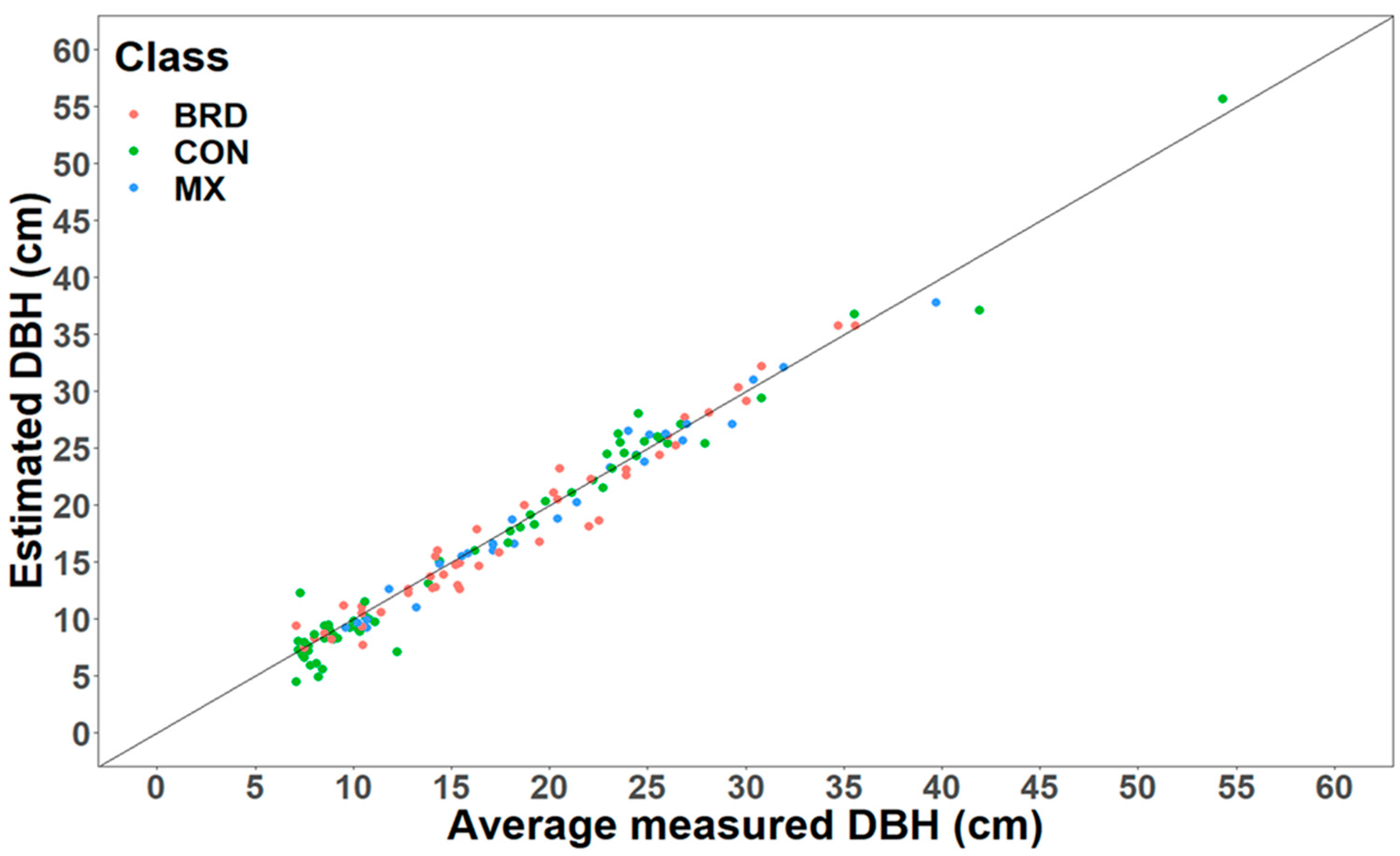
| Site | Age | Measured Trees * | Density (Stems ha−1) ** | Species Composition *** | Average DBH (cm) | Understory Class (1–5) |
|---|---|---|---|---|---|---|
| BRD 20–40 | 35 | 19 | 2419 | Pt74 Sb26 | 13.1 | Low (2) |
| BRD 41–60 | 45 | 7 | 1019 | Pt80 Pj10 Bw10 | 20.9 | Dense (4) |
| BRD 61–80 | 74 | 9 | 1273 | By50 Mr50 | 16.0 | Moderate (3) |
| BRD 81–100 | 91 | 8 | 1146 | Pt100 | 29.7 | Moderate (3) |
| BRD 101+ | 114 | 3 | 764 | Pt100 | 21.5 | Very Dense (5) |
| CON 20–40 | 27 | 23 | 2928 | Sb91 Pj9 | 10.4 | Low (2) |
| CON 41–60 | 54 | 12 | 1528 | Bf83 Pt17 | 19.5 | Very Dense (5) |
| CON 61–80 | 74 | 2 | 382 | Pj100 | 30.6 | Low (2) |
| CON 81–100 | 91 | 15 | 1909 | Pj100 | 21.9 | Minimal (1) |
| CON 101+ | 105 | 7 | 1146 | Cw78 Bf11 Bw11 | 23.8 | Minimal (1) |
| MX 20–40 | 25 | 8 | 1401 | Pt64 Pj18 Sb16 | 17.4 | Minimal (1) |
| MX 41–60 | 50 | 8 | 1146 | Bf44 Bw22 Sb22 Ag12 | 14.9 | Moderate (3) |
| MX 61–80 | 70 | 2 | 254 | Sw50 Bw50 | 28.4 | Very Dense (5) |
| MX 81–100 | 84 | 6 | 764 | Pt50 Bf30 Sw20 | 28.4 | Dense (4) |
| MX 101+ | 109 | 4 | 764 | Pj66 Pt34 | 25.4 | Minimal (1) |
| Site Name | Mean Measured DBH (cm) | Mean Estimated DBH (cm) | MAE (cm) | MAE (%) |
|---|---|---|---|---|
| BRD 20–40 | 13.1 | 12.7 | 1.1 | 8.4 |
| BRD 41–60 | 20.9 | 20.9 | 1.3 | 6.2 |
| BRD 61–80 | 16.0 | 15.3 | 1.6 | 10.0 |
| BRD 81–100 | 29.7 | 29.8 | 0.6 | 2.0 |
| BRD 101+ | 18.7 | 17.7 | 1.9 | 10.2 |
| CON 20–40 | 10.4 | 9.4 | 1.0 | 9.6 |
| CON 41–60 | 14.8 | 14.6 | 2.0 | 13.5 |
| CON 61–80 | 30.6 | 31.3 | 0.7 | 2.3 |
| CON 81–100 | 21.9 | 21.9 | 0.9 | 4.1 |
| CON 101+ | 23.8 | 24.8 | 1.1 | 4.6 |
| MX 20–40 | 17.4 | 17.3 | 0.6 | 3.4 |
| MX 41–60 | 14.9 | 13.9 | 1.2 | 8.1 |
| MX 61–80 | 28.4 | 26.9 | 1.5 | 5.3 |
| MX 81–100 | 26.2 | 26.1 | 0.5 | 1.9 |
| MX 101+ | 25.4 | 25.6 | 1.3 | 5.1 |
| Factor | Factor Level | Number of Trees | Mean Absolute Error (cm) | Relative Mean Absolute Error (%) |
|---|---|---|---|---|
| Species Class | Broadleaf | 46 | 1.19 | 7.30 |
| Conifer | 59 | 1.16 | 9.45 | |
| Mixed | 28 | 0.90 | 4.91 | |
| Age Class | 20–40 | 50 | 0.96 | 8.19 |
| 41–60 | 27 | 1.56 | 13.05 | |
| 61–80 | 13 | 1.48 | 8.94 | |
| 81–100 | 29 | 0.72 | 3.01 | |
| 101+ | 14 | 1.30 | 5.66 | |
| Density Class (Stems ha−1) | 250–500 | 4 | 1.13 | 3.92 |
| 500–1000 | 13 | 1.03 | 4.59 | |
| 1001–1500 | 47 | 1.09 | 6.24 | |
| 1501–2000 | 12 | 1.95 | 19.66 | |
| 2001–2500 | 34 | 0.98 | 6.25 | |
| 2501–3000 | 23 | 1.00 | 9.88 | |
| Understory Class | Minimal (1) | 34 | 0.91 | 4.06 |
| Low (2) | 44 | 1.01 | 8.77 | |
| Moderate (3) | 25 | 1.17 | 7.34 | |
| Dense (4) | 15 | 0.99 | 4.87 | |
| Very Dense (5) | 15 | 1.94 | 17.59 | |
| Tree Species | Balsam Fir | 17 | 1.31 | 14.80 |
| Black Spruce | 35 | 0.92 | 8.99 | |
| Cedar | 5 | 0.80 | 3.39 | |
| Green Ash | 1 | 0.80 | 7.48 | |
| Jack Pine | 13 | 0.92 | 3.55 | |
| Red Maple | 4 | 2.02 | 9.21 | |
| Trembling Aspen | 46 | 1.15 | 5.72 | |
| White Birch | 5 | 1.26 | 6.30 | |
| White Spruce | 2 | 1.75 | 6.31 | |
| Yellow Birch | 5 | 1.32 | 12.74 | |
| DBH Class (cm) | 7–10 | 30 | 1.08 | 13.58 |
| 10.1–15 | 28 | 1.13 | 9.49 | |
| 15.1–20 | 23 | 1.02 | 5.95 | |
| 20.1–25 | 25 | 1.32 | 5.81 | |
| 25.1–30 | 17 | 0.82 | 3.02 | |
| 30.1–35 | 5 | 0.94 | 2.97 | |
| 35.1–40 | 3 | 1.13 | 3.00 | |
| 40.1–50 | 1 | 4.80 | 11.46 |
| Factor(s) | Df | Test Statistic | p-Value | Effect Size | Magnitude of Effect |
|---|---|---|---|---|---|
| Age Class | 4 | 25.95 | 3.24 × 10−5 | 0.17 | Large |
| Density Class | 5 | 16.26 | 6.15 × 10−4 | 0.09 | Moderate |
| Site Species Class | 2 | 2.78 | 0.25 | 0.01 | Small |
| Understory | 4 | 20.40 | 4.17 × 10−4 | 0.13 | Moderate |
| DBH Class | 8 | 25.67 | 1.40 × 10−3 | 0.14 | Moderate |
| Species | 9 | 12.67 | 0.18 | 0.03 | Small |
| Age Class × Density Class | 13 | 39.08 | 1.94 × 10−4 | 0.22 | Large |
| Age Class × Site Species Class | 14 | 39.69 | 2.85 × 10−4 | 0.22 | Large |
| Age Class × Understory | 12 | 39.34 | 9.23 × 10−5 | 0.23 | Large |
| Density Class × Site Species Class | 13 | 37.86 | 3.04 × 10−4 | 0.21 | Large |
| Density Class × Understory | 14 | 39.69 | 2.85 × 10−4 | 0.22 | Large |
| Site Species Class × Understory | 9 | 25.76 | 2.23 × 10−3 | 0.14 | Moderate |
| DBH Class × Age Class | 27 | 43.99 | 0.02 | 0.16 | Large |
| DBH Class × Density Class | 27 | 37.83 | 0.08 | 0.10 | Moderate |
| DBH Class × Site Species Class | 22 | 39.92 | 0.01 | 0.16 | Large |
| DBH Class × Understory | 29 | 55.36 | 6.43 × 10−3 | 0.20 | Large |
| Age Class × Species | 22 | 45.91 | 2.03 × 10−3 | 0.22 | Large |
| Density Class × Species | 22 | 36.26 | 0.03 | 0.13 | Moderate |
| Species × Understory | 21 | 49.49 | 4.29 × 10−4 | 0.26 | Large |
| Factor | Group 1 | Group 2 | N1 | N2 | Statistic | p-Value |
|---|---|---|---|---|---|---|
| Age Class | 20–40 | 81–100 | 50 | 29 | −3.67 | 2.39 × 10−4 |
| Age Class | 41–60 | 81–100 | 27 | 29 | −4.79 | 1.66 × 10−6 |
| Age Class | 61–80 | 81–100 | 18 | 29 | −2.92 | 3.50 × 10−3 |
| DBH Class | 7–10 cm | 25.1–30 cm | 30 | 17 | −3.71 | 2.09 × 10−4 |
| DBH Class | 10.1–15 cm | 25.1–30 cm | 28 | 17 | −3.65 | 2.61 × 10−4 |
| Density Class | 1001–1500 | 1501–2000 | 47 | 12 | 3.23 | 1.24 × 10−3 |
| Density Class | 1501–2000 | 2001–2500 | 12 | 34 | −3.01 | 2.61 × 10−3 |
| Density Class | 1501–2000 | 501–1000 | 12 | 13 | −3.4 | 6.66 × 10−4 |
| Understory | Minimal (1) | Low (2) | 34 | 44 | 2.85 | 4.39 × 10−3 |
| Understory | Minimal (1) | Very Dense (5) | 34 | 15 | 4.08 | 4.45 × 10−5 |
| Understory | Dense (4) | Very Dense (5) | 15 | 15 | 3.17 | 1.50 × 10−3 |
Disclaimer/Publisher’s Note: The statements, opinions and data contained in all publications are solely those of the individual author(s) and contributor(s) and not of MDPI and/or the editor(s). MDPI and/or the editor(s) disclaim responsibility for any injury to people or property resulting from any ideas, methods, instructions or products referred to in the content. |
© 2024 by the authors. Licensee MDPI, Basel, Switzerland. This article is an open access article distributed under the terms and conditions of the Creative Commons Attribution (CC BY) license (https://creativecommons.org/licenses/by/4.0/).
Share and Cite
Guenther, M.; Heenkenda, M.K.; Morris, D.; Leblon, B. Tree Diameter at Breast Height (DBH) Estimation Using an iPad Pro LiDAR Scanner: A Case Study in Boreal Forests, Ontario, Canada. Forests 2024, 15, 214. https://doi.org/10.3390/f15010214
Guenther M, Heenkenda MK, Morris D, Leblon B. Tree Diameter at Breast Height (DBH) Estimation Using an iPad Pro LiDAR Scanner: A Case Study in Boreal Forests, Ontario, Canada. Forests. 2024; 15(1):214. https://doi.org/10.3390/f15010214
Chicago/Turabian StyleGuenther, Matthew, Muditha K. Heenkenda, Dave Morris, and Brigitte Leblon. 2024. "Tree Diameter at Breast Height (DBH) Estimation Using an iPad Pro LiDAR Scanner: A Case Study in Boreal Forests, Ontario, Canada" Forests 15, no. 1: 214. https://doi.org/10.3390/f15010214
APA StyleGuenther, M., Heenkenda, M. K., Morris, D., & Leblon, B. (2024). Tree Diameter at Breast Height (DBH) Estimation Using an iPad Pro LiDAR Scanner: A Case Study in Boreal Forests, Ontario, Canada. Forests, 15(1), 214. https://doi.org/10.3390/f15010214








